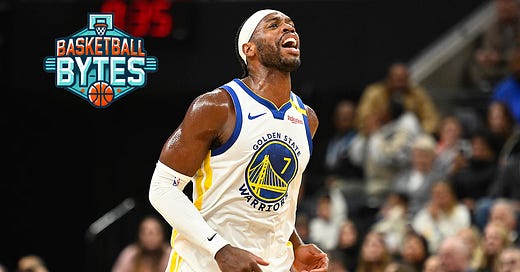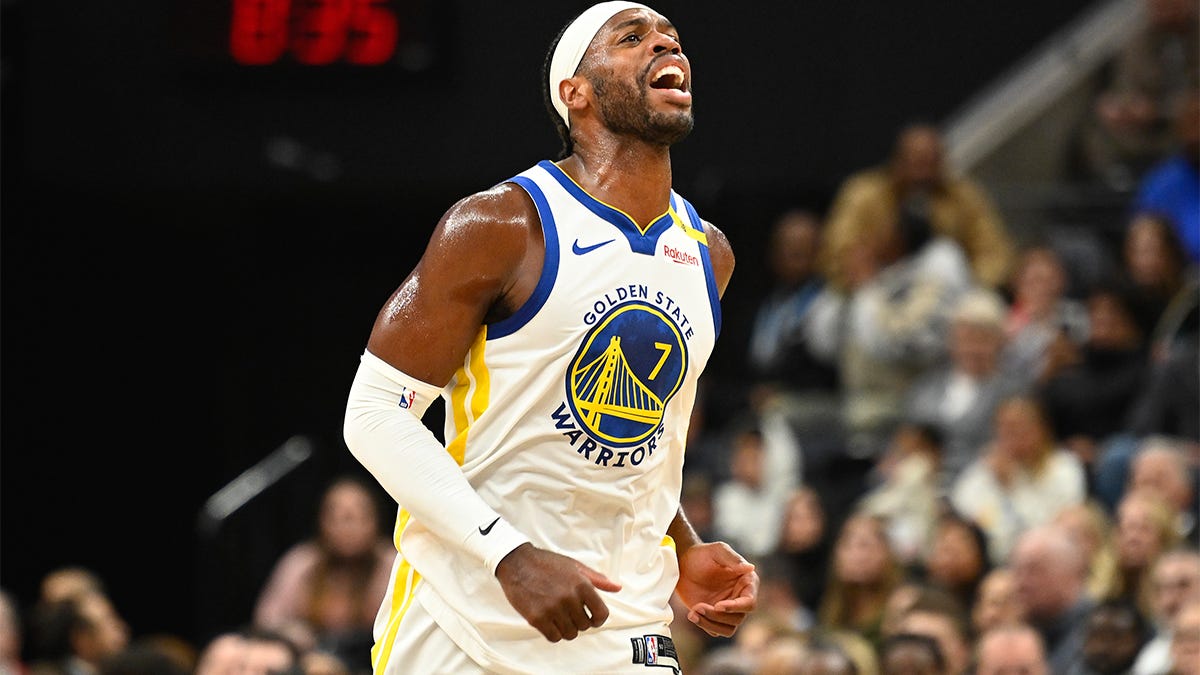Basketball Bytes: Who’s Getting the Ball More (or Less) This Year?
A look at players who have added — or subtracted — the most Usage Rate so far this season. Plus, a tale of two Donovan Mitchell teams.
Welcome to Basketball Bytes — a ✨brand-new spin-off✨ of my baseball column, in which I point out several byte-sized pieces of information that jumped out to me from my various basketball spreadsheets. If you’ve noticed a Basketball Byte of your own, email me and I’ll feature it in a future column!
🏀 From Role Players to Ball Hogs (or Vice-Versa)
In any sport, it’s tempting to dive into early stats and look for definitive trends right away.
This urge comes from a couple of places. For one, us statheads love ✨new data✨ from a ✨new season✨ — after months of waiting since the end of the previous season, with nothing but offseason projections and speculative reports to tide us over, it’s exciting to finally put our skills to work on real results again. Getting a new season’s data feels like unwrapping presents on Christmas morning.
And, of course, we also feel compelled to mine a dataset for the same reason George Mallory wanted to climb Mount Everest: "Because it's there."
This kind of data-exuberance can sometimes get us into trouble. But the good news is that some NBA stats start telling us real things faster than others. While it’s probably unwise to draw sweeping conclusions from, say, early 3-point shooting percentages, stats tied to player tendencies — such as Usage Rate — tend to offer a better signal-to-noise ratio even with limited minutes.
With that in mind, I wanted to look at the players who have already seen the biggest positive and negative changes in usage in 2024-25 versus 2023-24 so far. (With a minimum of 1,000 minutes per 82 team games in both seasons.) We’ll also pair that with the player’s change in Offensive Rating, just to gauge how efficient each player has started out in his new role early this year.
(Note: Feel free to explore the chart to see where your favorite player stands!)
Unsurprisingly, there is a slight — and I do mean slight1 — negative correlation between changing usage and efficiency year-over-year. (Don’t worry, we’re not going to rehash those old usage/efficiency tradeoff debates again.) But some players have had bigger changes than we might expect, in all directions.
For instance, without either Paul George or Kawhi Leonard to play with anymore,2 James Harden has gone from a near career-low usage of 20.6% last year to 31.8% (his highest since 2019-20) this year. No player has seen a larger bump in offensive responsibility thus far. But now that he’s gone back to being The System, Harden has a career-low 103 offensive rating — with a very poor 26.8 3P%, which should probably rebound some, but also uncharacteristically mortal rates of turnovers, drawing fouls and even attempting 3s.
Harden is arguably the most efficient high-usage scorer in NBA history, and he used to be routinely capable of carrying a usage well into the 30s (peaking at a near-record 40.5% in 2018-19) while producing around 120 points per 100 possessions. But at age 35, it’s worth watching whether Harden still can take on so many possessions while still being the efficient force we’re used to seeing — and whether it will even matter to the Clippers in the end. Though Leonard is supposed to eventually return, this Harden-centric offense currently ranks 25th and L.A. has a mere 16% playoff probability.
By comparison, the second-biggest positive change in usage belongs to Buddy Hield, who had a career-low 19.2% usage in Indiana and Philadelphia last season but is now up to a career high of 28.6% with Golden State.
Unlike Harden, whose efficiency has cratered in going back to a larger role, Hield has thrived with a return to the higher usage he had in Sacramento earlier in his career. His 132 offensive rating is fueled by a 51.7 3P% —no, that’s probably not going to persist — but also a low turnover rate and plenty of scoring while filling guard minutes for a Warriors team that needed it with Klay Thompson departing and Steph Curry injuring his ankle.
There’s also the opposite end of the usage spectrum — players who have lost the most touches since last season. Some guys have used the reduced responsibility to produce more efficiently: Check out Caris LeVert of the Cavs (more on them in a bit), who had a 23.1% usage and 110 offensive rating in 28.8 MPG with Cleveland last year; this season, LeVert is down to an 18.2% usage and 21.7 MPG but also a team-best 145 offensive rating with more assists, fewer turnovers and better shooting percentages on both 2s and 3s.
(Similarly, Tim Hardaway Jr. and Taurean Prince have been far more efficient in lower-usage roles. And despite the Sixers’ general struggles, Kyle Lowry has been wildly efficient with less usage in this, his age-38 season.)
Finally, a number of players have lost both usage and efficiency to start the year. I had thought Alex Caruso would be an excellent addition to OKC at both ends of the court, and he has had the expected positive influence on their league-best defense… but his offense (-5.1 Estimated RAPTOR, 79 offensive rating) has regressed badly while posting a microscopic 10.9% usage rate.
Others who’ve lost at least 20 points of offensive rating and 4 percentage points of usage include Andre Drummond and Gary Trent Jr. And Jamal Murray is an interesting case. Even before suffering a concussion versus Minnesota last Friday, his usage was down from 27.9% to 21.3% with Christian Braun taking a larger role and newcomer Russell Westbrook doing his Russell Westbrook thing. (Murray’s assist rate is also way down, from 31.2% to 18.3%.) But Murray’s efficiency hasn’t increased with the reduced responsibility, dipping from a 119 offensive rating to 111.
Surely Murray will improve on his low 3P% (30.4), much like many of the other players who have lost efficiency from a year ago, so these early offensive ratings are probably going to change a lot by season’s end. But as we said earlier, usage is a lot less volatile of a metric, even in smaller sample sizes — so the real point of our chart above is to flag the players experiencing extreme changes in their roles, whether they’ve been expanded or contracted.
🏀 Cavs Up, Jazz Down
As of Sunday, the team with the biggest gain in the Elo ratings (up 63 rating points) since preseason is the Cleveland Cavaliers, who have started a perfect 7-0 with Top-5 rankings on both side of the ball. Donovan Mitchell (+4.6 Estimated RAPTOR) is playing great, scoring 39.4 points per 100 possessions on 60.8% True Shooting, his supporting cast is putting up much-improved numbers and the Cavs are up to No. 8 in the championship odds rankings.
But I’m struck by how the Cavs have already started hot like this a few times in their recent era of post-LeBron renaissance. In 2021-22, before they even added Mitchell, Cleveland gained 49 Elo points through the first seven games of the season, and in 2022-23 they improved by 66 points early on — even more than they have so far this year:
The only exception in recent seasons came in 2023-24, when they were down 27 Elo points after the first seven games of the year. (They would hover around a pretty even level for most of the first half, before making their big gains at midseason.)
But these Cavs of recent vintage also have a history of peaking earlier than they might prefer: In that 2021-22 season, they lost 129 Elo points from their peak, went 9-15 in the second half and ultimately lost the play-in. A year later, they held mostly steady, even finding a slightly higher new level for the stretch run, but they were unceremoniously bounced from the first round of the playoffs against the Knicks in 5 games. And last year’s team was all over the place — starting barely better than .500, heating up for multiple midseason win streaks, going 12-17 after the All-Star Game and then winning a playoff series before bowing out against the eventual champs.
All of which is to say, it’s been pretty tough to know what kind of Cavaliers we’re going to get by season’s end based on their early returns in recent years.
And then there are the biggest Elo losers of the early going. I’ve already written some (and am due to write more later this week) about the Sixers, whose Elo has dipped by a league-high 69 points since preseason, but I also wanted to highlight a team who has fallen by nearly as much: the Utah Jazz (-59).
Donovan Mitchell’s old team was an object of interest for me last season because of their own strange arc. After a highly mediocre first six weeks of the 2023-24 campaign, the Jazz suddenly caught fire, went 15-4 in the lead-up to New Year’s and the subsequent few weeks… and then fell apart completely again.
Nonetheless, Utah had some interesting players! They were the league’s ninth-youngest team. Lauri Markkanen had a +3.8 Estimated RAPTOR at age 26; Collin Sexton was a +2.5 at age 25. Walker Kessler was just 22 and had a 9.2% block rate. 20-year-old Keyonte George flashed his moments of potential. John Collins used to be pretty good. This was a roster with pieces that might, in theory, contribute to a good team — and in fact, the Jazz even played like a good team over a 6-to-8-week span last year.
And yet, the 2024-25 Jazz are bad. Like, very bad. They’re winless in six games, with only two of those games even being competitive. They lost by 41 at home against the Warriors. Victor Wembanyama put up 25, 9, 7, 5 and 5 against them in their own building on Halloween night. George and Cody Williams have been the two worst players in the league. I could go on, but you get the idea.
In keeping with this column’s theme, it’s still very early. The Jazz could once again tap into whatever potential they unlocked last year — or maybe they don’t even want to. (In retrospect, that hot streak hurt their draft positioning.) Either way, they’re experiencing the lows in a mirror image to Cleveland’s highs right now. But both teams’ recent up-and-down arcs remind us that every team is still probably far from where they will wind up by season’s end.
Filed under: NBA, Basketball, Basketball Bytes
It’s -0.16.
George hopped to the Sixers while Leonard has been out all year with a knee injury.






